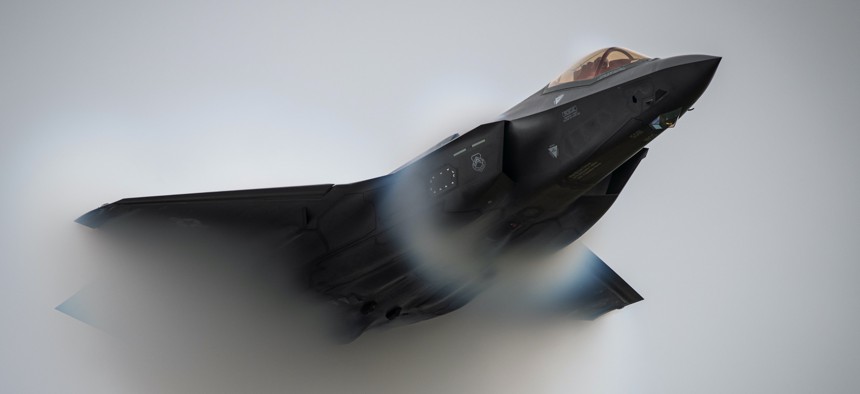
Air Force Capt. Andrew “Dojo” Olson, commander of the F-35 Demonstration Team, performs a high-speed pass during the Oregon International Airshow in McMinnville, Ore., Sept. 21, 2019. Air Force Senior Airman Alexander Cook
Defense Business Brief: Leonardo DRS plans IPO; F-35 changes ahead?; Space war rundown; and more...
JUST IN: Italian defense and aerospace firm Leonardo is planning an initial public offering for Leonardo DRS, the company’s American arm, the company said in a Friday SEC filing. The transaction, which must undergo a regulator review, is expected to be finished by the end of March, the company said in a statement. Leonardo plans to list its stock on the New York Stock Exchange using the ticker DRS. (Reuters reported on Wednesday that the company was exploring an IPO for DRS.)
The company, founded as DRS Technologies, was acquired in 2008 for $5.2 billion by Finmeccanica, which later renamed itself Leonardo and its American property Leonardo DRS.. It has been run since 2012 by Bill Lynn, a former U.S. deputy defense defense secretary who diversified its Army-heavy portfolio and streamlined its corporate structure.
In other merger-and-acquisitions news, Leidos plans to buy naval design firm Gibbs & Cox for $380 million in cash. Also, AeroVironment completed its $405 million acquisition of drone-maker Arcturas.
At the Air Force Association Aerospace Warfare Symposium — held virtually due to the COVID-19 instead of its usual venue in Orlando, Florida — Gen. Charles Q. Brown, the Air Force chief of staff, said the service is committed to the F-35, but it might buy fewer than currently planned. The number of planes purchased hinges on the results of a fleet mix study that will inform the Pentagon fiscal 2022 budget request.
Of note, the Air Force requirement for 1,763 F-35s was set by the 1997 Quadrennial Defense Review. Obviously, the world has changed a lot over the past 24 years, so it will be interesting to see what options the new study suggests.
Also at AFA: Gen. Kenneth Wilsbach, head of Pacific Air Forces, called for buying the Boeing-made E-7 Wedgetail radar plane to replace aging E-3 AWACS, Air Force Magazine reports. But Brown — Wilsbach’s boss — said he wants to explore other options before committing to Wedgetail.
Over to Abu Dhabi where the International Defence Exhibition, known as IDEX, concluded with 62,445 in-person attendees coming through the venue over five days, organizers said. The UAE armed forces signed $5.7 billion in arms deals over the five-day exhibition.
Staying in the region, the Center for International Policy has a new issue paper breaking down U.S. arms sales to Egypt. “For more than forty years, Egypt has been among the largest recipients of U.S. military aid. It has received an annual allotment of more than $1.3 billion in U.S. assistance since 1987, totaling more than $41 billion, much of which is used to purchase American weaponry.” Read the whole brief here.
Weekend reading: “The proliferation of counterspace weapons across the globe often calls into question what can be done to best protect satellites from attack. This analysis from the CSIS Aerospace Security Project addresses different methods and technologies that can be used by the United States government, and others, to deter adversaries from attack.” Read the report here.
 From Defense One
From Defense One
Troubled KC-46 Tankers Cleared for Limited Ops, Air Force Says // Marcus Weisgerber
The decision will free up older aerial refuelers needed overseas. But the KC-46 still can gas up only some warplanes and needs more testing and new technology.
F-35 Still the 'Cornerstone' Fighter, Top Air Force General Says // Marcus Weisgerber
After calling for a new fighter, Gen. Brown clarified the F-35 is alive and well while a new study reevaluates fighters and drones for 2036.
Space Firms Put Aside Rivalries to Share Threat Data // Marcus Weisgerber
A new clearinghouse has begun gathering and distributing information about threats to space networks, products, and services.
Leidos Deepens Maritime Reach with Planned Acquisition of Gibbs & Cox Naval Design Firm // Marcus Weisgerber
It's the latest move to better position itself for Navy undersea business.
How China's Digital Silk Road Is Leading Countries Away from the United States // Patrick Tucker
Beijing is using technology products, markets, and training to secure influence with U.S. security partners, a IISS report finds.
Hyten: US Must Broaden Its Strategic Deterrence Concept — and Keep Its ICBMs // Patrick Tucker
The Joint Chiefs vice chair said a "new strategic defense review" should take account of communications and sensors.
Island-Hopping F-35s Test Pacific Air Forces' Agility Concept // Patrick Tucker
A pair of jets flew two missions from different airfields on the same day in a bid to complicate Chinese targeting.
Pentagon Looks to Tap 5G in Space // Brandi Vincent
"Any aspect of 5G applied to any aspect of space systems is of potential interest," says a new request for information.




